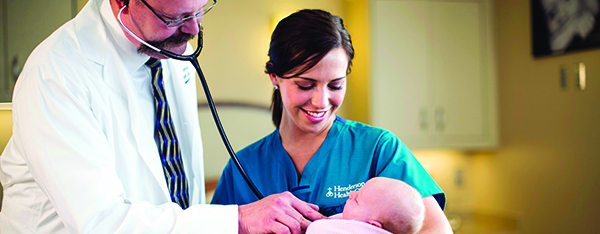Diagnostic Imaging
Imaging
Henderson Health Care makes it easy to access quality diagnostic imaging close to home.
Imaging is the technology used by radiologists to diagnose and treat disease. Thanks to the advancement of imaging technology, physicians can now have a clear understanding of what is going on inside your body without a single incision. At HHC, a wide range of imaging technology is available to help diagnose your condition quickly and accurately — and get you on the road to treatment and recovery. Imaging plays a huge role in modern medicine. It is very effective at helping physicians determine the specific plan of care for each patient.
Ultrasound
Henderson Health Care is pleased to announce the purchase of a state-of-the-art 3D/4D ultrasound machine.
4D ultrasound provides live streaming video of the baby in the womb rather than the still image created by 3D. 4D ultrasound allows visualization of embryonic movements two weeks earlier than 2D ultrasound.
The 4D image also aids in preparation for pediatric surgery if that is indicated. It is an indispensable tool for early detection of brain dysfunction. The ultimate goal is early detection of possible fetal distress or abnormal behavior before birth, not detected so far with prior examinations.
Our ultrasound technicians are highly skilled and accredited practitioners with years of experience, trained on the latest technology and equipment in the field.
Radiology
Radiology uses imaging technologies, such as X-ray radiography, magnetic resonance imaging (MRI), nuclear medicine, ultrasound, computed tomography (CT), and positron emission tomography (PET) to see within the human body in order to diagnose disease and abnormalities. The complete list of radiology specialties offered by HHC include:
Computed Tomography (CT) — One of the most commonly used tools to examine the brain, chest, abdomen, and pelvis, CT scans help diagnose a range of conditions that attack the lungs, soft tissue, bones, and blood vessels by taking thin slices (images) of your insides.
DEXA Scan — This noninvasive scan is recommended for men over age 65 and post-menopausal women with a history of ovarian failure, estrogen deficiency, osteoporosis, long-term steroid therapy, and hyperparathyroidism. DEXA scan measures an individual’s bone density and determines whether he or she is experiencing the beginning or advanced stages of osteoporosis. Henderson Health Care has a new DEXA scanner with the latest technology located at the imaging center.
Magnetic Resonance Imaging (MRI) — Frequently called upon to diagnose problems affecting the spinal cord and brain, MRI uses a high-powered magnet and radio waves to create accurate and detailed images.
3D Mammography — This technology has become the gold standard for the early detection of breast cancer. The American Cancer Society recommends a baseline mammogram at age 35 and annually for all women over the age of 40 (earlier for women with personal or family histories of breast cancer).
Nuclear Medicine — This imaging technology uses a special radioactive material that is picked up and visualized with nuclear technology to catch diseases affecting the gallbladder, heart and thyroid.
Ultrasound — Ultrasound has a multitude of uses, ranging from diagnosing conditions of the blood vessels and organs to visualizing soon-to-be-born babies. 3D/4D ultrasound is also available.
Vascular Doppler — an ultrasound that estimates your blood flow through blood vessels. It is used as an alternative to more invasive tests.
X-Ray — Probably what first comes to mind when you think of radiology, X-ray technology helps physicians visualize bones, soft tissues, and some of your organs.
Convenience
When you need a quality imaging examination fast, take comfort knowing it’s available close to home at the hospital you’ve come to know and trust. We offer outpatient services on the hospital campus—all the imaging services you need with easy access to parking.
Imaging technology is constantly changing and Henderson Health Care is continually upgrading our technology and looking for ways to improve the imaging experience.
Patient Feedback
"Thank you HHC for giving our family protection, health, assurance, & true care. The "Forever Moments" held in our hearts have so many of you in them. We could not have written our family's beginning any better. We were able to bring our 4 children into this world with full faith in the people providing us care in our most helpless, but most beautiful moment."


